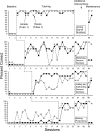Teaching math skills to at-risk students using home-based peer tutoring
- PMID: 17624064
- PMCID: PMC1885408
- DOI: 10.1901/jaba.2007.108-05
Teaching math skills to at-risk students using home-based peer tutoring
Abstract
Home-based peer tutoring was used to teach math skills to 4 girls with deficits in mathematics and histories of abuse or neglect. Girls living in the same home formed tutoring dyads, and each participant served as both the peer tutor and the tutee during the course of the study. At the initiation of the tutoring intervention, an expert tutor provided multiple 3-min tutoring sessions to the designated peer tutor on three or four mathematics skills. The peer tutor concurrently provided 3-min tutoring sessions on the same skills to the tutee using a multiple baseline design. Results showed that participants improved their performance on all target skills. Additional interventions were implemented for some skills to improve accuracy further. Maintenance tests were also administered after 3 to 5 months of no practice on the skills. Results showed that tutors and tutees maintained their accuracy on 7 of the 12 skills assessed.
Figures




Similar articles
-
Children's learning-by-teaching with a social robot versus a younger child: Comparing interactions and tutoring styles.Front Robot AI. 2022 Oct 31;9:875704. doi: 10.3389/frobt.2022.875704. eCollection 2022. Front Robot AI. 2022. PMID: 36388256 Free PMC article.
-
Effects of participation in a cross year peer tutoring programme in clinical examination skills on volunteer tutors' skills and attitudes towards teachers and teaching.BMC Med Educ. 2007 Jun 28;7:20. doi: 10.1186/1472-6920-7-20. BMC Med Educ. 2007. PMID: 17598885 Free PMC article.
-
Peer tutoring in a medical school: perceptions of tutors and tutees.BMC Med Educ. 2016 Mar 8;16:85. doi: 10.1186/s12909-016-0589-1. BMC Med Educ. 2016. PMID: 26956642 Free PMC article.
-
Teaching mathematics to students with mild-to-moderate mental retardation: a review of the literature.Ment Retard. 2001 Feb;39(1):20-31. doi: 10.1352/0047-6765(2001)039<0020:TMTSWM>2.0.CO;2. Ment Retard. 2001. PMID: 11270211 Review.
-
A Bayesian approach to generating tutorial hints in a collaborative medical problem-based learning system.Artif Intell Med. 2006 Sep;38(1):5-24. doi: 10.1016/j.artmed.2005.04.003. Epub 2005 Sep 23. Artif Intell Med. 2006. PMID: 16183267 Review.
Cited by
-
Peer tutoring and mathematics in secondary education: literature review, effect sizes, moderators, and implications for practice.Heliyon. 2019 Sep 28;5(9):e02491. doi: 10.1016/j.heliyon.2019.e02491. eCollection 2019 Sep. Heliyon. 2019. PMID: 31687584 Free PMC article.
-
Single-case experimental designs: a systematic review of published research and current standards.Psychol Methods. 2012 Dec;17(4):510-50. doi: 10.1037/a0029312. Epub 2012 Jul 30. Psychol Methods. 2012. PMID: 22845874 Free PMC article.
-
A comparison of two flash-card methods for improving sight-word reading.J Appl Behav Anal. 2011 Winter;44(4):781-92. doi: 10.1901/jaba.2011.44-781. J Appl Behav Anal. 2011. PMID: 22219529 Free PMC article.
References
-
- Arreaga-Mayer C, Terry B.J, Greenwood C.R. Classwide peer tutoring. In: Topping K, Ehly S, editors. Peer-assisted learning. Mahwah, NJ: Erlbaum; 1998. pp. 105–119.
-
- Burley M, Halpern M. Educational attainment of foster youth: Achievement and graduation outcomes for children in state care (No. 01-11-3901) Olympia: Washington State Institute for Public Policy; 2001.
-
- Calhoun M.B, Fuchs L.S. The effects of peer-assisted learning strategies and curriculum-based measurement on the mathematics performance of secondary students with disabilities. Remedial and Special Education. 2003;24:235–245.
Publication types
MeSH terms
LinkOut - more resources
Full Text Sources
Medical

